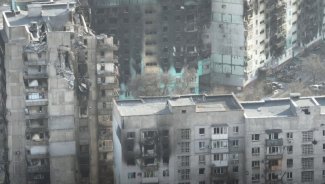Russia’s attack on Ukraine: day 33

The General Staff of the Armed Forces of Ukraine noted for the first time the intensification by the enemy of strikes on fuel depots. It also pointed to the problems involved – not only logistical, but also humanitarian. After 33 days of war, Russian forces are to continue to be held back in all directions and Ukrainian forces to carry out effective counter-attacks. The artillery shelling and rocket-air strikes (especially the destruction of cities) are presented by the Ukrainian side as an attempt by the enemy to compensate for the failures related to the weakening, disorientation, logistical problems and lowering of the combat potential of the subdivisions. In connection with the losses incurred in Russia, recruitment of volunteers for the occupation forces is to continue. In order to replenish the arsenal, the aggressor is to switch missile production companies to 24-hour operation, but in doing so faces challenges from Western sanctions.
According to Ukrainian information, in the north-eastern direction the main arena of fighting and exchange of fire remains the areas west of Kyiv. The Ukrainian defence perimeter north of the M06 highway is based on the villages of Lisne, Kapitanivka and Dmytrivka, and south of this route it is made up of Motyzhyn, Lychanka, Shpytky and Petrushky. To the northwest of the capital, clashes are ongoing over Moshchun in the Hostomel area. Russian forces shelled the railway infrastructure near Boyarka, causing train traffic to be halted southwest of Kyiv. The liberation of the city from the occupants was announced by the mayor of Irpin (throughout the fighting it remained about 80% under the control of the defenders). The following day Chernihiv and Nizhyn were shelled, as well as Ukrainian positions in the village of Lukyanivka, which had been recaptured a few days earlier.
In the eastern direction, fighting is taking place mainly on the border of Kharkiv and Donetsk oblasts, where the Russians are operating with the forces of the 1st Tank Army and the 20th Combined Arms Army of the Western Military District. Ukrainian units are holding back the enemy’s advance towards Sloviansk and the town of Barvinkove. The situation remains unclear in Izium and the villages of Topolske and Kamyanka to the south of it, which were the main defensive perimeter for many days (Ukrainian forces are still defending themselves there or trying to regain control). Clashes in the northern and eastern outskirts of Kharkiv continued for another day. The city and Ukrainian positions in the Chuhuiv area were also shelled. In the Luhansk Oblast, Rubizhne, Lysychansk (the bordering Sievierodonetsk was shelled for another 24 hours) and Popasna are defending themselves, and in the Donetsk Oblast, Avdiyivka, Mariyinka, New York and Novomykhailivka (west and north of Donetsk), as well as Vuhledar and Solodke, located 20 km east of it. In total, the defenders were to repel seven enemy attacks in Donbas within 24 hours. They also hold positions in the centre of Mariupol. According to the Azov regimental staff’s assessment, two to three battalion tactical groups are needed to deblock the city.
In the south-eastern direction, the invading forces continued their shelling and made attempts to break Ukrainian positions south of Zaporizhzhia and Kryvyi Rih. In Zaporizhzhia Oblast, the line of contact between the troops has not changed (the main targets of the attacks were the defenders’ positions in the area of Stepnohirsk and Huliaipole). In turn, in the Dnipropetrovsk Oblast, the Russians stormed Blahodatne, 25 km south of Kryvyi Rih. The aggressor forces were to be pushed back to their existing positions 40–60 km from the city centre. Mykolaiv is being bombed. More fuel depots were also the target of Russian missile strikes – in Nikopol in the Dnipropetrovsk Oblast and, for the second time, near Rivne.
As the armed conflict prolongs, official communiqués from both sides describing enemy losses are increasingly becoming an instrument of information warfare. The Ukrainian General Staff in its daily messages increases Russian casualties by 100–300 people. The current estimate is 17,200 enemy soldiers killed. The aggressors focus on reporting on the equipment damage to the Ukrainian army and on reinforcing the thesis that the enemy is already practically defenceless, and do not assess its human losses. According to the latest data from the General Staff of Ukraine, the invaders lost 597 tanks, 127 aircraft, 129 helicopters, 1,710 armoured vehicles, 303 artillery systems, 96 multi-propelled rocket launchers, 54 air defence systems, 1,178 wheeled vehicles, 7 vessels, 73 tankers and 71 UAVs. In contrast, according to Russian data, the Ukrainians have so far destroyed 123 aircraft, 74 helicopters, 311 UAVs, 1738 tanks and other armoured fighting vehicles, 181 rocket launchers, 726 guns and mortars and 1592 motor vehicles.
The arms conglomerate Ukroboronprom has reported that repair work is underway at functioning repair facilities not only on damaged equipment of the Ukrainian army, but also on captured equipment – Russian Smiercz and Uragan rocket artillery systems and Osa air defence systems. Since the beginning of the conflict, the company’s enterprises have been gradually relocated to so-called safe regions, most likely to the western oblasts of Ukraine.
The Russians continue their brutal occupation of occupied territories, including in the Kyiv, Zaporizhzhia, Chernihiv, Kherson and Kharkiv oblasts – shelling and looting residential buildings, terrorising the population, kidnapping and holding hostages. In Henichesk, they have begun paying pensions to residents in Russian currency – 10,000 roubles (3,000 hryvnias, less than 100 euros) in cash – and from April they plan to introduce roubles for trade and settlement throughout the Kherson Oblast. Citizens queue up but immediately exchange the currency for hryvnias, and local shops do not accept roubles. On 28 March, residents of Enerhodar gathered for a peaceful rally to once again protest against the occupation. The demonstrators demanded the release from captivity of the first deputy mayor. Another local government representative – the chairman of the Balakliia city council in Kharkiv Oblast – decided to cooperate with the invaders. Earlier (26 March) he and two other officials were kidnapped by the Russians. The head of the administration of the Kharkiv Oblast described his decision as treason and reminded him that this act is punishable by 15 years imprisonment or life imprisonment. In turn, the mayor of Mariupol, Vadym Boychenko, called for the immediate full evacuation of the city. He reported that there are about 160,000 people there, who have no more water or food supplies and are on the brink of life and death. Mariupol has been under blockade for 29 days, being systematically destroyed by rocket attacks and heavy artillery fire.
In Kharkiv, 1177 residential buildings, 53 kindergartens, 69 schools and 15 hospitals were destroyed by Russian shelling and air strikes.
According to the State Bureau of Investigation, more than 1,700 persons subject to mobilisation attempted to leave Ukraine illegally. Cases of launching channels for smuggling men across the border have been confirmed, and organisers of such procedures have been detained in Vinnytsia, Chernivtsi, Odesa and Lviv oblasts. According to the bureau’s data, by 28 March, more than 340 criminal proceedings have been initiated, of which about 100 are related to high treason and collaboration, including the collaboration of ten customs and law enforcement officers with the occupant.
Since the beginning of the conflict, the Security Service of Ukraine has eliminated five hostile bot farms controlling more than 100,000 fake accounts on social networks. They operated on the territory of Kharkiv, Cherkassy, Ternopil, Poltava and Transcarpathian Oblast. Their purpose was to spread false information about the war situation and to justify the actions of the aggressor troops.
On 29 March, it was agreed to launch three humanitarian corridors in Donetsk and Zaporizhzhia oblasts – from Mariupol, Melitopol and Enerhodar to Zaporizhzhia. On 28 March, 880 Mariupol residents were evacuated from Berdiansk.
President Volodymyr Zelensky announced the establishment of a group of experts to analyse the sanctions imposed on Russia. He reiterated his call for the immediate tightening of restrictions, including on the import of energy resources, and expressed indignation that the West is holding off on new restrictions until Moscow uses chemical weapons. At the same time, he called on the public to cool down excessive euphoria over local victories by the Ukrainian army, acknowledged that the situation was very difficult, and stressed that the country needed arms supplies and the public needed to have patience.
Ukraine starts selling electricity to Poland. On 28 March Ukrenerho resumed daily auctions for electricity exports. The first auctioned capacity was purchased by the DTEK concern owned by Rinat Akhmetov, and deliveries are to start on 30 March. This is the first auction after the unification of the country’s system with the European ENTSO-E network. According to Ukrenerho, Ukrainian electricity is 70% from low-carbon sources and gives EU members the opportunity to replace Russian gas.
Secretary of the Security Council of the Russian Federation Nikolai Patrushev said that Moscow’s goal is not to overthrow the regime in Kyiv, but to “demilitarise and denazify Ukraine”. According to him, air strikes are being carried out as part of a “special operation” against the main resistance points, airfields and places where weapons and military equipment of the Ukrainian army are stored. Patrushev’s statement coincided with the start of Russian-Ukrainian talks in Turkey; it indicates that the Russians will continue combat operations despite talks being underway and that they treat their military pressure as a tool that could force Kyiv to accept the unfavourable terms of the ceasefire more quickly.
According to the Polish Border Guard, 21,000 people entered Poland from Ukraine on 28 March (a 22% drop from the previous day), and a total of 2.344 million since the start of the invasion.
Commentary
• The Ukrainian side is trying to regain positions on the outskirts of Kyiv and Kharkiv, which it then tries to present in the media as its tactical counteroffensive. In other areas of the clashes – also in the majority of towns north and west of the capital – the aggressor is conducting offensive actions. However, the line of contact between the fighting units remains relatively stable, and the Ukrainian defensive positions were effectively broken or bypassed only in the direction of Sloviansk and the town of Barvinkove, where the invader units entered the Donetsk Oblast from the north. Encircling the Ukrainian grouping in the Donbas, however, requires breaking through the defences north of Donetsk and Gorlovka, where Russian troops have been unsuccessful for many days, and the rallying operations they have been conducting towards the border with the Kharkiv Oblast do not allow a stable blockade line to be established.
• Official communiqués from the Ukrainian and Russian militaries remain part of information warfare and are often impossible to verify. It is a common practice to provide data aimed at lowering the credibility of the enemy and strengthening the conviction that they are deliberately underestimating their own losses. The Ukrainian side is also using this move as a psychological tool to make the Russians distrust the leadership of their own army.
• For the first time, the Ukrainian side reported cases of evasion of military service and escapes of persons subject to mobilisation across the western and southern borders of the country. Even though the number of fugitives is not large, it is a first sign of war fatigue and growing reluctance of taking part in armed conflict. The defeatist moods are being exploited by smugglers who, for a high fee, are engaged in smuggling people across the border.
• President Zelensky’s appeal to the Ukrainian public suggests that the authorities are becoming increasingly wary of the prospect of prolonged hostilities, including the risk of further enemy offensives and increasing numbers of collaborations, often enforced by Russians’ deliberate creation of humanitarian crises. In this context, Kyiv is trying to cool down the rhetoric of success it has been building for the past month, which has kept up the morale of its citizens but also fuelled hopes of a quick defeat of the Russians. There is a growing frustration with the insufficient military aid from the West and an awareness of the need to prepare the population for long-term sacrifices.





